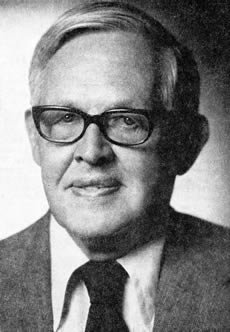George G. Lorentz
Biography

One of the Russian empresses imported into Russia a substantial number of Germans to develop agriculture on the land and small industries in towns. For generations these loyal citizens of Russia maintained their German language and kept their membership in the Lutheran Church. George Lorentz was one of those Germans. The Communist regime in Russia even made a separate state of a section of German population and called it Volga Autonome Soviet Republic.
George Lorentz was born in 1910 in St. Petersburg, Russia, became a candidate at the University of Leningrad in 1935, and was lecturer in mathematics there 1936-1942. He was married in 1942, and he and his wife eventually had 5 children. In 1942 they happened to be in a region occupied by the German army. They were sent to Poland in a camp for foreigners and refugees. While there he wrote up a piece of mathematics that he had done and attempted to have it sent for publication in a German mathematics journal edited by Konrad Knopp. The University of Tübingen professors were kind to him and arranged his transfer to Tübingen to help one of them write books in mathematics. He became there a doctor rer. nat. (math) in 1944 and later (in 1972 and 1996) was awarded honorary doctorates by the Universities of Tübingen and Würzburg. He served at Universität Frankfurt 1946-1948, Tübingen 1948-1949, Toronto 1949-1953, and as professor at Wayne State 1953-1958, SU 1958-1969 and Texas-Austin 1969-1980. He was awarded the Humboldt Prize, A von Humboldt Stiftung, in 1973, and became emeritus in 1980 at age 70, but still pursues a very active research career.
Konrad Knopp and he directed at Tübingen in 1950 the Ph.D. dissertation of Wolfgang Jurkat, who was on the SU faculty off and on from 1957 to 1991, and Lorentz is credited at his Mathematics Genealogy web site with 16 Ph.D. students and 108 descendants. He directed the SU Ph.D dissertations of the following individuals: George Clements (1962), Albert Vosburgh (1965), Louis Deluca (1966, now deceased), John Scheick (1966), John Roulier (1968), Sherman Riemenschneider (1969), James Case (1970).
His research interests were in mathematical analysis, especially approximations and expansions; summability; Birkoff interpolation; functional analysis, especially Banach function spaces; interpolation theory for operators. His research was supported by a number of grants from NSF and OSR (Office of Scientific Research), and he was a member of AMS, MAA and the German Mathematical Society.
George Lorentz died January 1, 2006 at age 95. See the memorial resolution from University of Texas.
Sources: Mathematics Genealogy web site and American Men and Women of Science 2002. Erik Hemmingsen wrote an initial partial version, Phil Church added to it, and George Lorentz adjusted and corrected it. Phil Church 7/13/02, 8/28/02, and 6/3/08.
